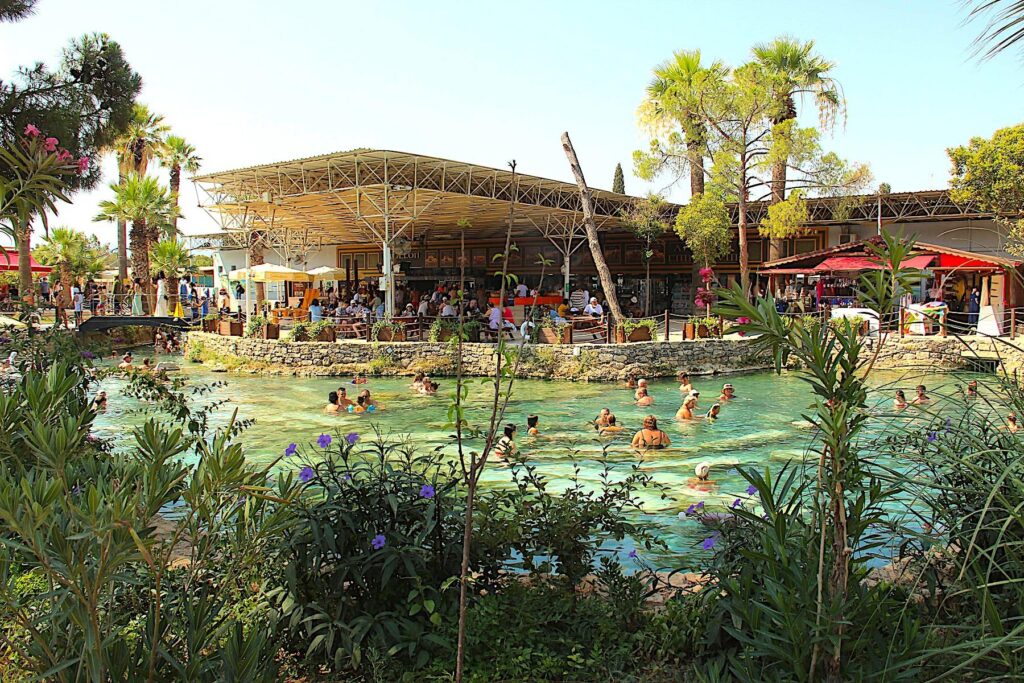Hierapolis Ancient City, located immediately adjacent to Pamukkale in southwestern Tūrkiye, is a UNESCO World Heritage site known for its rich historical significance and stunning natural beauty. As a tourist destination, it offers a fascinating blend of ancient ruins and thermal springs. Established in the 2nd century B.C., Hierapolis was a thriving Greco-Roman city, and today, visitors can explore well-preserved structures like the theatre, Necropolis, and the Temple of Apollo. The city’s proximity to the Pamukkale travertines and white mineral terraces formed by thermal waters add to its appeal. Tourists can enjoy walking on these terraces and bathing in ancient thermal pools like the famous Cleopatra’s Pool. Hierapolis offers a unique experience, combining historical exploration with relaxation in nature’s thermal wonders.
Location: North entrance & car park – Develi, 20190 Pamukkale/Denizli. South gate & car park – Güney Kapı, 20280 Pamukkale/Denizli. Town/lower entrance (via travertines) – Memet Akif Ersoy Blv., 20190 Pamukkale/Denizli.
Hierapolis Ancient City – Table of Contents
Brief History of Hierapolis
In the early 7th Century B.C., the Phrygians (Central/west Anatolian Indo-European speaking peoples of 12th to 6th Century B.C.) built a temple dedicated to the mother goddess Cybele on the site used by the indigenous communities living in the Lykos valley. The ancient Cybele cult was gradually assimilated into the Greek religion when the Greek colonists arrived and built the city on the pre-existing settlement. The extraordinary landscape of Pamukkale’s petrified waterfalls 200 metres over the valley was a focus of interest for ancient visitors to the adjacent Hellenistic spa town of Hierapolis, founded by the Attalid kings of Pergamon (Greek state ruling western Asia Minor 282 – 129 B.C.) at the end of the 2nd century B.C.
Ceded to Rome in 133 B.C., Hierapolis flourished, reaching its peak of importance in the 2nd and 3rd centuries A.D., having been destroyed by an earthquake in 60 A.D. and rebuilt. Remains of the Greco-Roman period include baths, temple ruins, the monumental arch, the nymphaeum, the necropolis and the theatre. Following the acceptance of Christianity by the emperor Constantine and his establishment of Constantinople as the ‘new Rome’ in 330 A.D., the town was made a bishopric. As the place of St. Philip’s martyrdom in 80 A.D., commemorated by his Martyrium building in the 5th century, Hierapolis, with its several churches, became an important religious centre for the Eastern Roman Empire.
The last Roman emperor who visited Hierapolis was Valens (Eastern Roman Emporer 364 – 378 A.D.) in 370 A.D. When, in the 4th century B.C., another earthquake demolished many buildings in the city, its gradual decline began. An earthquake finally ended the town’s existence as a significant urban centre in the 7th century B.C.
Hierapolis Name & Archaeology
The name Hierapolis, derived either from the Greek word hieron meaning temple or from the name of Hiera, the wife of the mythical founder of the city, Telephos, the son of Heracles and Princess Auge, the ancestor of the Attalids of Pergamon.
The first measurements and preliminary surveys of the Hierapolis area were carried out in 1887 by a German archaeological mission under the direction of Carl Humann. His notes were published in 1889 in the book “Altertümer von Hierapolis”. Since 1957, excavations and reconstruction work carried out by Italian archaeologists have been ongoing, and many ancient buildings have been excavated and restored from the sediments. Some of the finds are in collections in museums in London, Berlin, and Rome, and exhibits are currently displayed at the local Archaeological Museum on site.
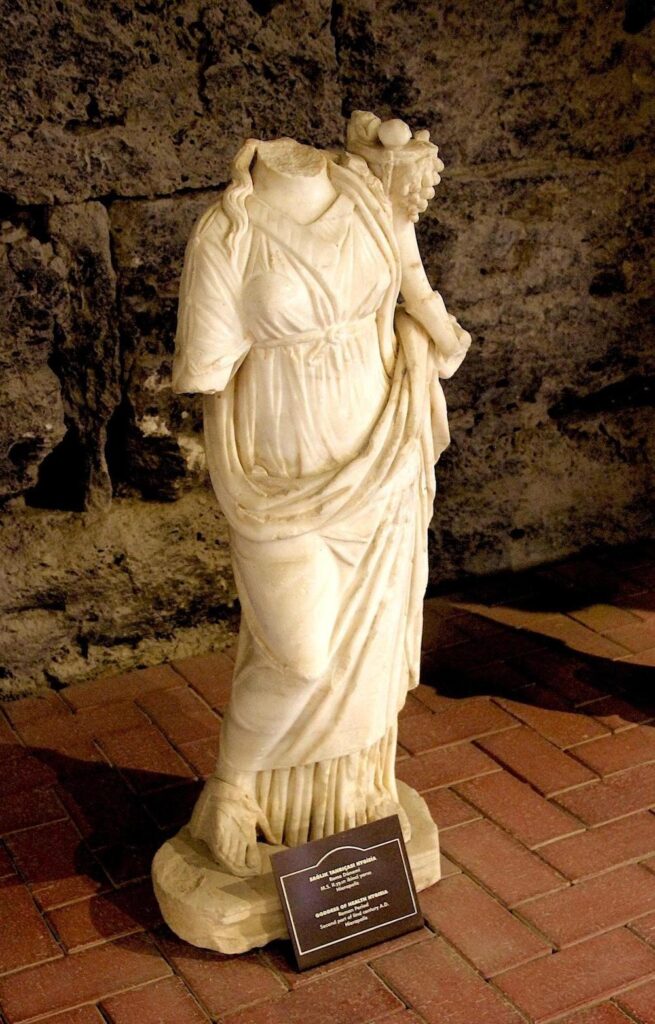
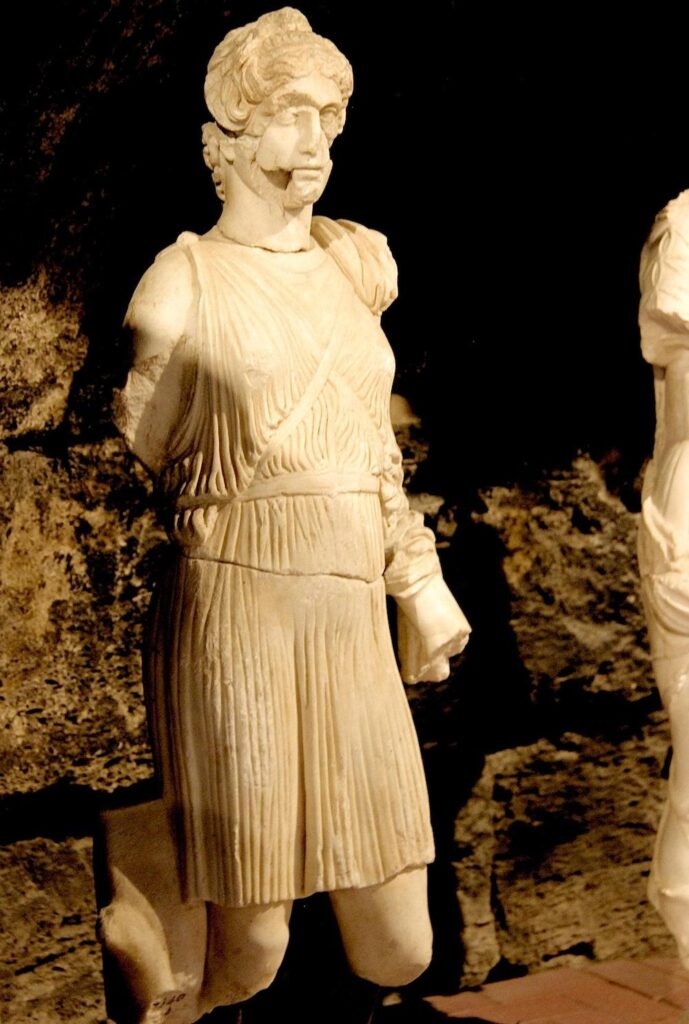
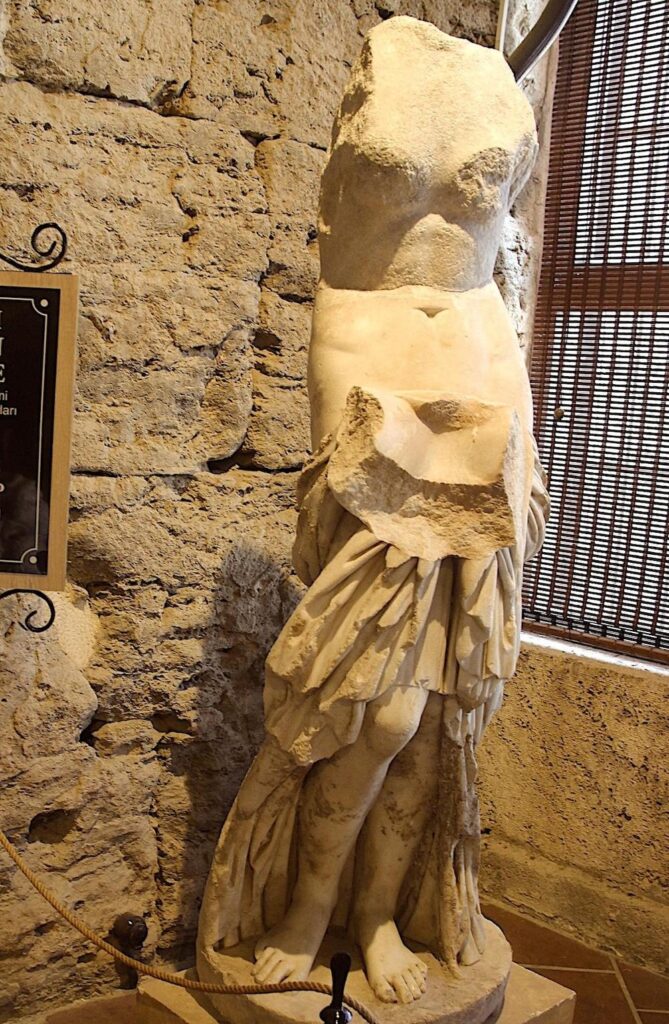
(Heirapolis South Wall)
UNESCO World Heritage Site
The area covering 1,077 hectares around Hierapolis was deemed a UNESCO World Heritage Site in 1988 based on several criteria, including (iii) Hierapolis is an exceptional example of a Greco-Roman thermal installation established on an extraordinary natural site, (iv) The Christian monuments of Hierapolis, erected between the 4th and the 6th centuries, constitute an outstanding example of early Christian architecture, and (vii) Calcite-laden waters from hot springs, emerging from a cliff almost 200 metres high overlooking the plain, have created a visually stunning landscape at Pamukkale.
Roman Theatre of Hierapolis
The well-preserved Theatre of Hierapolis commands a spectacular view of the plain below. The original theatre was located above the northern gate, but when the city was rebuilt during the reign of the Flavian emperors (60 A.D.), the theatre was relocated here, and the seats from the old structure were used in the rebuild. During the reign of Septimius Severus (193-211 A.D.), the scaenae frons (the elaborately decorated permanent architectural background of a Roman theatre stage) were modified and richly decorated with relief. In 532, it was discovered that the scaenae frons had been weakened by age, and frequent seismic activity had to be reinforced. With the recent restoration, it is now possible to see the friezes of mythological scenes depicting Apollo and Artemis in their original positions.
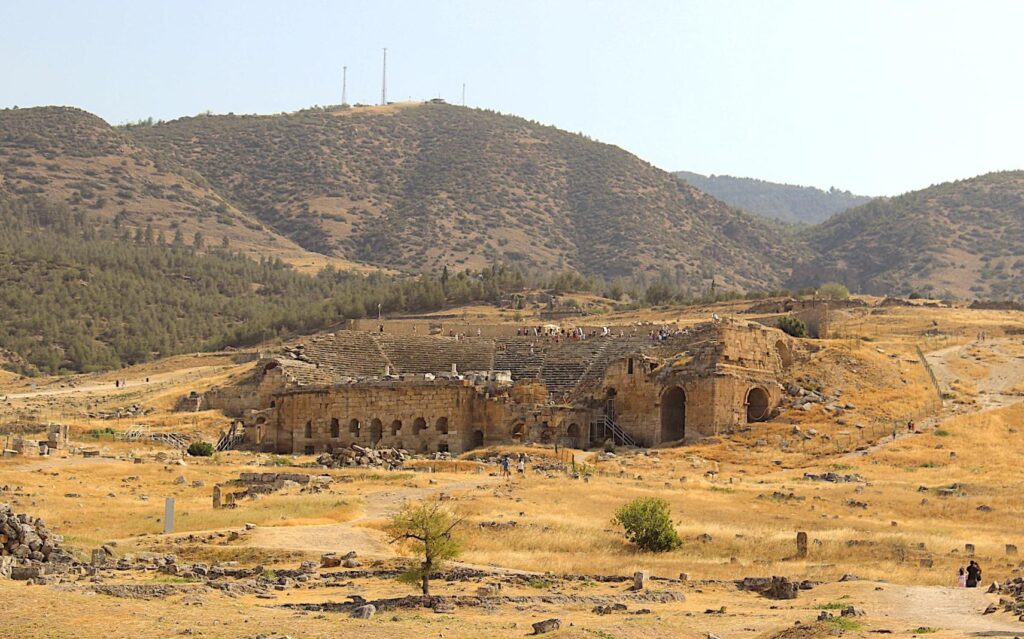
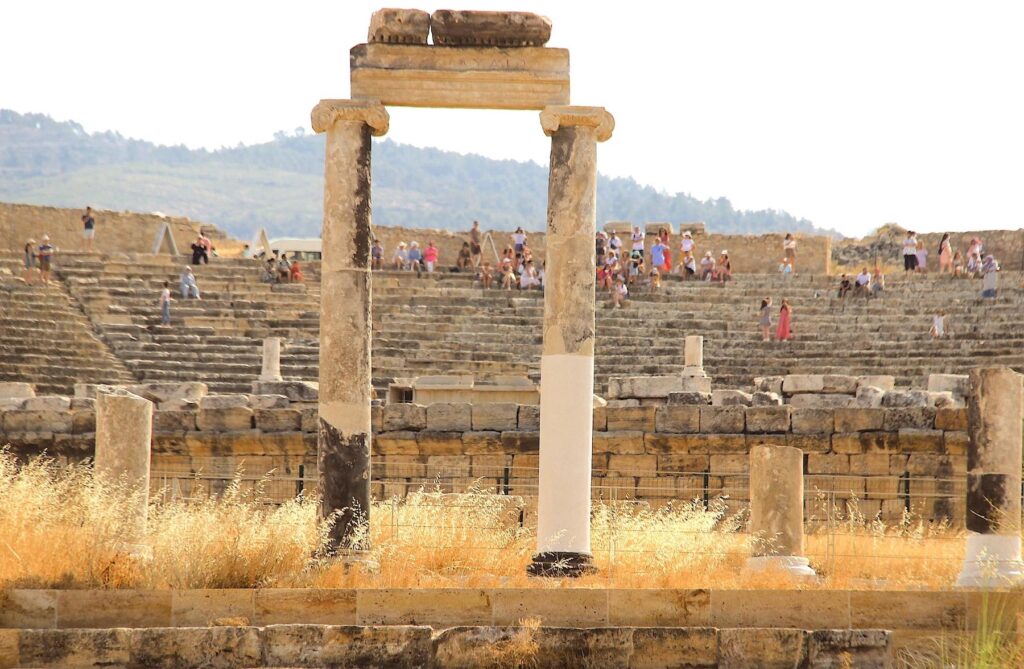
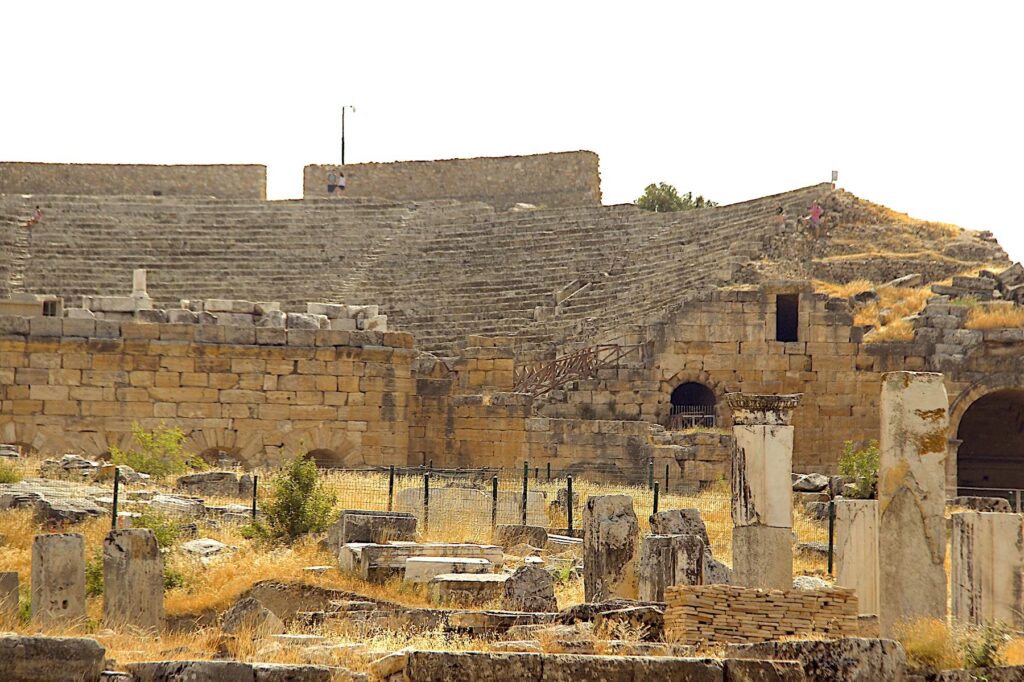
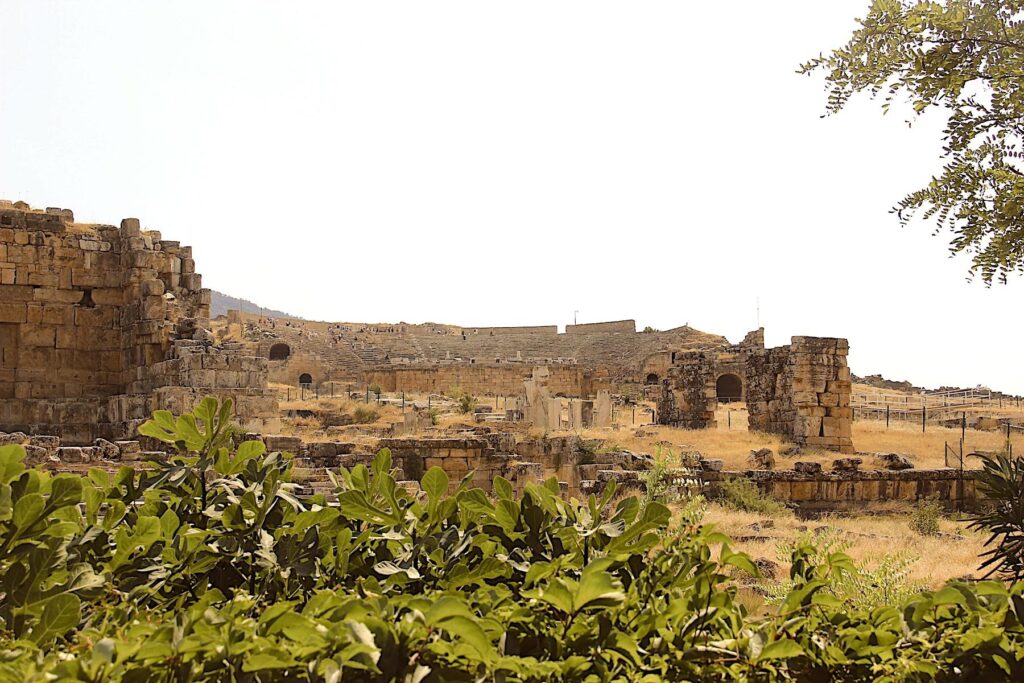
Thirty rows of the seats built against the slope have survived; initially, there would have been 20 rows in the lower part and 25 in the upper, separated by a diazoma (the horizontal) passage in an ancient theatre dividing the lower and upper rows of seats). The cavea (the vertical seating section in an ancient theatre) was split into eight aisles. In the lower part of the audience, there is a large marble exedra (semicircular niche with a raised seat), in which the most important spectators would be seated, decorated with sculpted lion-paws. It is estimated that the theatre could accommodate about 10,000 spectators.
The Gates Of Hierapolis
The Southern Byzantine Gate in the city walls dates back to Emperor Theodosius the Great, who reigned from 379 A.D. to 395 A.D. and was the last Emporer of Rome before the West and East empires split. It was built of travertine blocks and stones obtained from the agora. Its appearance is very similar to the Northern Gate: on both sides, there were defensive towers, and above the opening, there was an arched lintel. The gate has been restored, and it is the starting point of the sightseeing tour of Hierapolis for the tourists arriving at the eastern entrance.
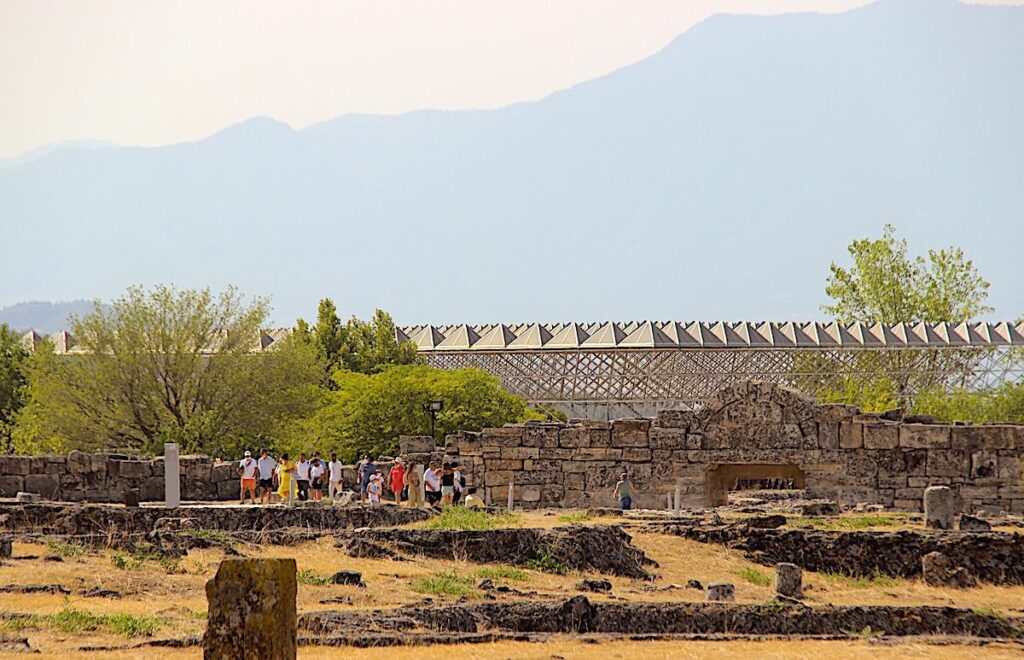
The Northern Byzantine Gate is part of the fortification system, which was also built around the city at the end of the 4th century A.D. and was a monumental entrance to the city during the Byzantine period. On both sides of the gate are two defensive towers on a square plan with a decorative arched lintel, including a cross symbol. Christian symbols are also visible on the façade’s entablature (the mouldings and bands which lay horizontally above the columns and their capitals). In addition, as a deterrent to evil powers, four marble blocks with carved heads of lions, panthers, and Gorgons from earlier ancient buildings were built on both sides of the gate.
The Gate of St. Philip is located on the north-eastern side of the defensive walls, which were also erected during the reign of Emperor Theodosius. Two towers on both sides of the entrance reflect its importance. Pilgrims went through the gateway to the top of the hill, where Saint Philip’s Sanctuary is.
Temple of Apollo
The visible remains of the Temple of Apollo date back to the 3rd century A.D., in the area where an important temple had already stood. In the Hellenistic period, it was dedicated to Apollo Lairbenos, the deity connecting the Greek Apollo with the local Anatolian sun god Lairbenos. Its inner courtyard was surrounded by marble porticoes decorated with doric semicolumns. Fragments of this earlier building, including the column capitals dated to the 1st century A.D., are exhibited in the Archaeological Museum.
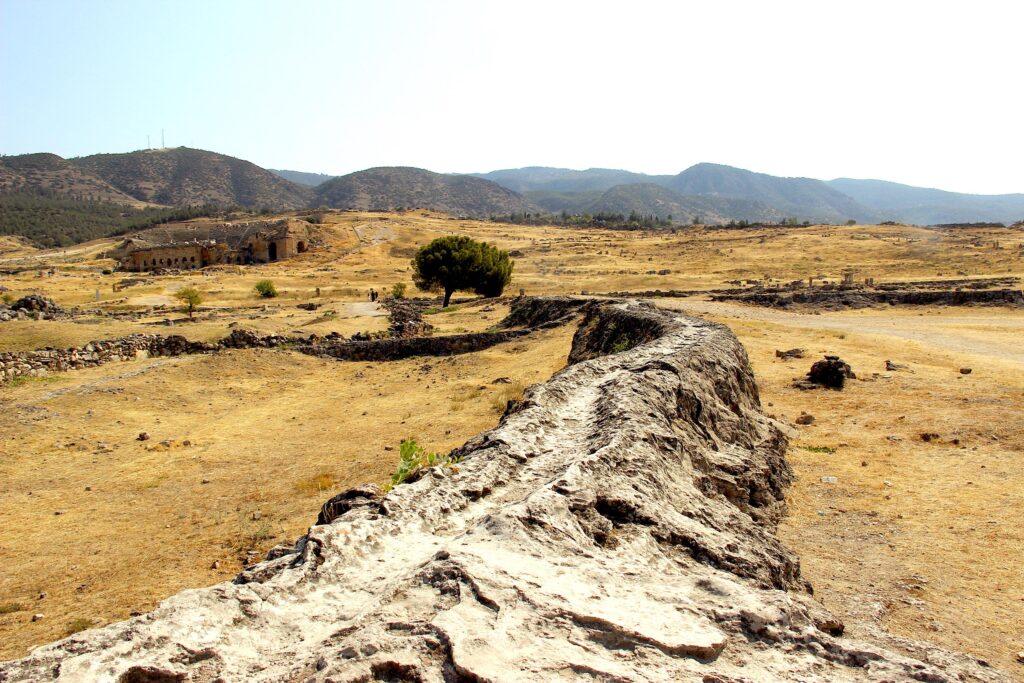
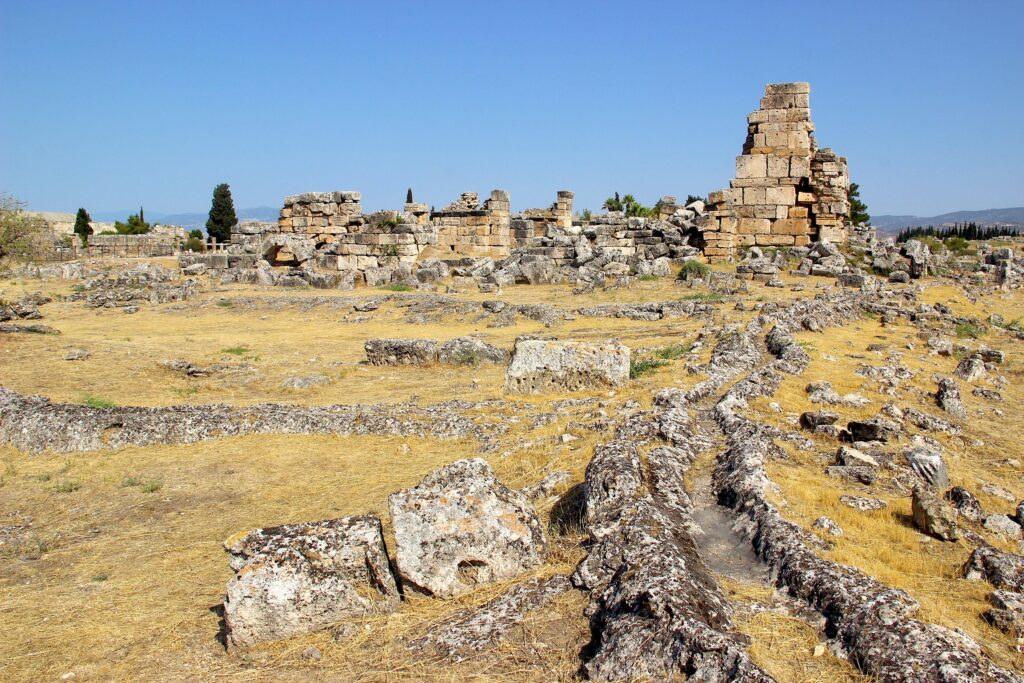
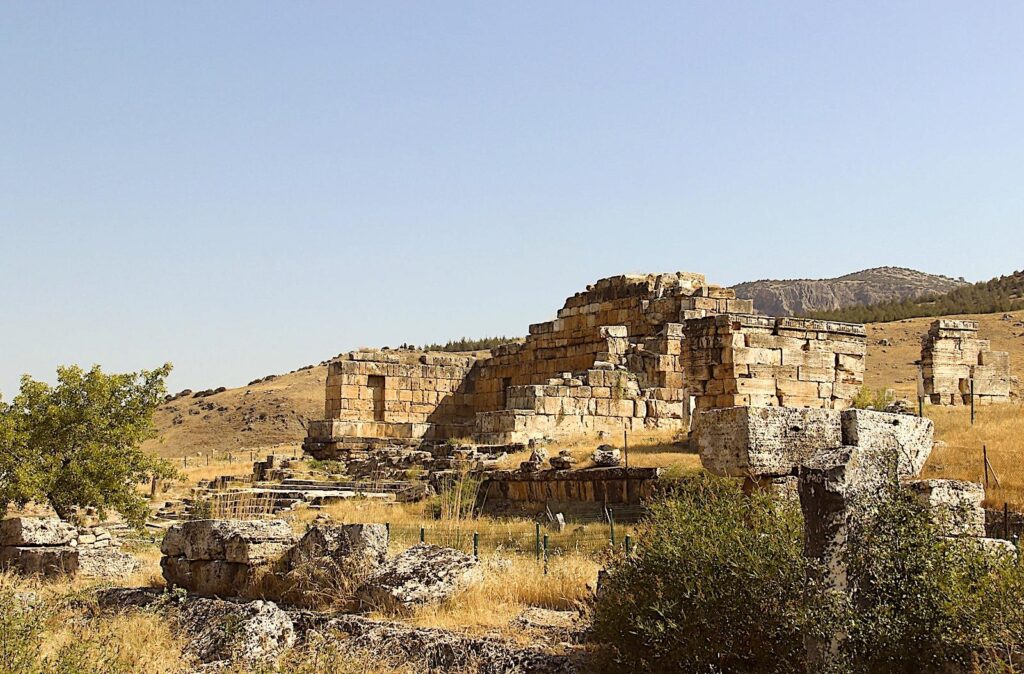
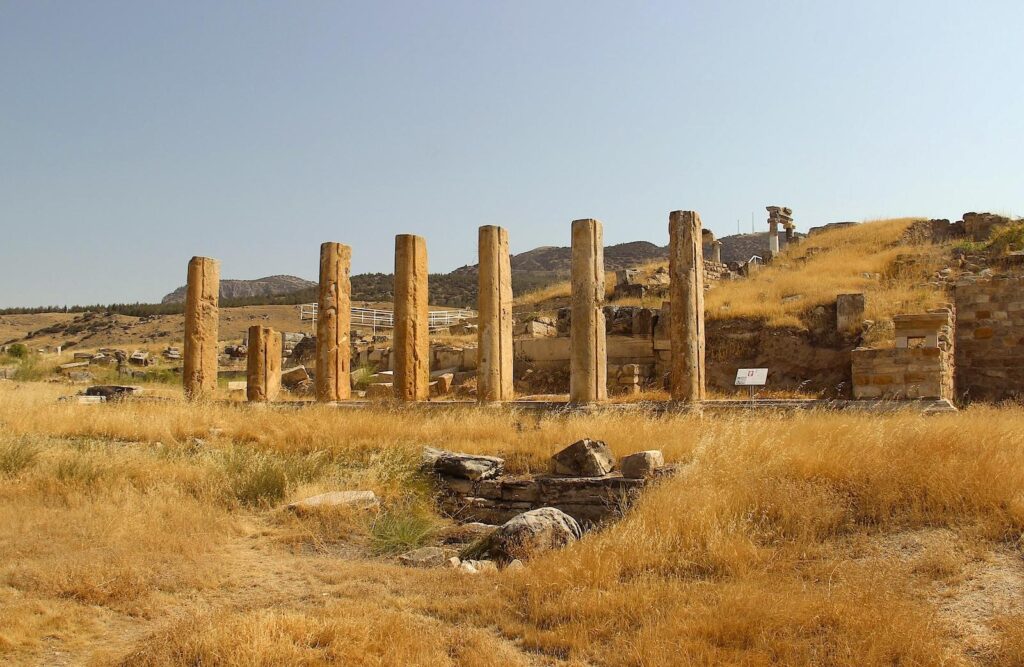

Ploutonion
The sanctuary dedicated to the god of the underworld, a deity, was known as Hades in Greece and Pluto in Rome, the gateway to the kingdom of Pluto. It was a small cave with narrow stairs, filled with poisonous (carbon dioxide) gas escaping from a tectonic fault. Priests descended into the cave to prove their relationship with the supernatural world, to avoid poisoning, they trained in the art of holding their breath; and would know the location of pockets of clean air. Believers were encouraged to purchase birds and other small animals that would be thrown into the Plutonium to demonstrate the poisonous properties of the cave. When the priests left the cavern unscathed, their powers and divine protection were illustrated to pilgrims, who were encouraged to donate to the temple in exchange for receiving a prophecy.
Nymphaeum of the Tritons
The nymphaeum, a monumental fountain, was also a sanctuary dedicated to the nymphs and is close to the ruins of the Temple of Apollo. The figures depicted in reliefs on this building are Tritons, mythical sea creatures (Mermen with the upper body of a human and tails of a fish). The nymphaeum, erected in the 2nd century A.D., supplied drinking water to houses in the city through a pipe distribution system. In the 5th century A.D., the Nymphaeum was renovated by adding a supporting wall using the fragments of the Temple of Apollo. The Triton Nymphaeum was one of the two giant fountains in the city. It had a sixty-metre façade, ending with short wings.

North & South Necropolis
The northern necropolis of Hierapolis is one of Anatolia’s most extensive ancient cemeteries, covering both sides of the road leading from Hierapolis to Tripolis, Philadelphia, and Sardis, for approximately 2km from the city gate. Most of the burials in its area date from the 2nd century B.C. to the 3rd century A.D., with more than 1,200 tombs identified. Deceased residents of Hierapolis and patients who unsuccessfully came for healing were buried. They include burial mounds from the Hellenistic period (with a narrow corridor leading to a burial chamber) covered with earth, family tombs resembling houses or small temples, sarcophagi decorated with reliefs and epitaphs and simple graves for poor citizens and slaves.
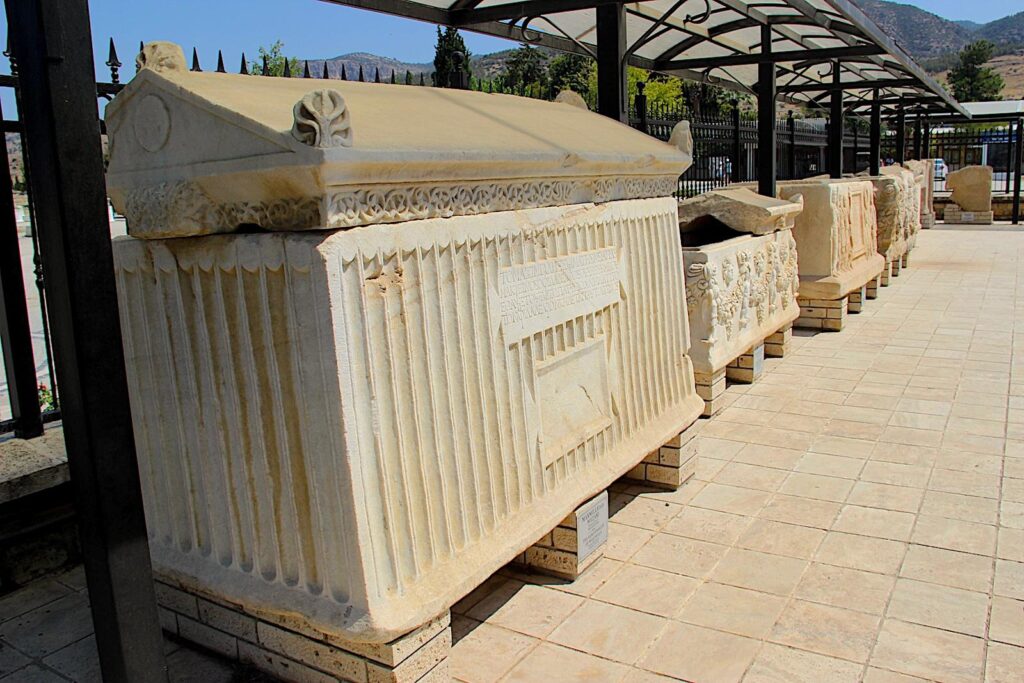
On the opposing side of Hierapolis, next to the road leading to Laodicea, is the southern necropolis, smaller and far less intact due to earthquake damage. The burial traces found in its area are, in most cases, simple, rectangular earth graves.
Church of Saint Philip’s Sepulchre
The three-nave church was unearthed during archaeological works in 2011 under Italian archaeologist Francesco D’Andria. The building was erected around the sepulchre (tomb – cavernous rock-cut space for interment), which was attributed to Saint Philip in the 4th or 5th century A.D. Early pilgrims coming in large numbers to the Sanctuary in Hierapolis first arrived at the narthex (an architectural element typical of early Christian and Byzantine basilicas consisting of the entrance or vestibule). From there, they could climb the marble staircase to the platform erected above the tomb or enter directly into the church. The tomb was located in the left aisle, while opposite the entrance stood an altar and synthronon (a semicircular tiered structure at the back of the altar in the liturgical apse that combines benches reserved for the clergy, with the bishop’s throne in the centre).
The tomb, dating to the 1st century A.D., is considered to be the burial place of Saint Philip. As such, it was extensively venerated in the Byzantine period. The tomb has a façade of travertine blocks, above which a triangular tympanum (decorative wall surface) rises. On the façade of the tomb are many inscriptions and holes, which served as the attachment points for metal ornamental offerings. The burial chamber, measuring approximately 3.5 x 4.0 meters, was equipped with three stone benches on which the bodies of the deceased were laid. On the right side of the tomb, in the church’s central nave, there are two small water tanks, once used for ritual immersion, and two larger pools lined with marble slabs. However, the remains of the apostle Philip are no longer in the tomb. According to Francesco D’Andria, the saint’s relics were likely moved from Hierapolis to Constantinople at the end of the 6th century A.D. and possibly later taken to Rome.
St. Philips Martyrium
Above the theatre is the Martyrion of Saint Philip, an octagonal building erected on a square measuring 20 x 20 meters and built in the early 5th century. The Martyrium of Saint Philip was the most important building in the city from the early Christian times. The entire building was planned to strengthen the symbolism of the number eight (symbolising the six days of creation, the seventh of rest and the eighth of eternal life). It consists of a central room on an octagonal plan, which connects eight rectangular rooms. Each was decorated with three arches supported by columns standing on marble, octagonal plinths. Christian symbols surrounded by circles are still visible on the arches. Once covered with a wooden dome, the central hall contains the synthronon, connecting the episcopal throne with the benches for clergy placed behind the altar. The central octagonal room was surrounded by a square building with 32 rooms along its sides.
The Martyrium was erected where Saint Philip the Apostle (one of the twelve Apostles of Jesus according to the New Testament) was said to have been martyred, as Eusebius of Caesarea (≈265 – 324 B.C.) reported in his biblical texts as the “Father of Church History”, considered to be the first Christian church historian. Philip the Apostle preached the Gospel in Greece, Scythia, Lydia, and Phrygia, where he was captured and executed. According to church tradition, he died on the cross in the shape of the letter “T”. In 2012, Bartholomew, the patriarch of Constantinople and primate of the Orthodox church celebrated St. Philip’s liturgy in the Church of the Sepulchre and the martyrium church of the Apostle.
The Great Baths and Hierapolis Archaeological Museum
The archaeological museum is located in the Roman Great Baths from the 2nd century A.D., one of the first ancient structures encountered when entering the Hierapolis area from the direction of Pamukkale’s travertine terraces. In the east section of the baths is a palaestra (a training area for combat sports such as wrestling and boxing) measuring 36 x 52 meters; immediately to the north and south of the palaestra are two large rooms that were reserved for the emperor and ceremonial use. A large hall stretches the length of the western side of the palaestra, which was the athlete’s gymnasium used by athletes. This hall led into the frigidarium (the cold room in a Roman bath), from which one proceeded to the barrel-vaulted rooms of the caldarium (hot plunge pool in a Roma bath). The small room adjacent to the large hall now serves as the museum where works discovered in the Hierapolis excavations are displayed. Since Hierapolis was principally a luxury resort town, it was richly adorned with magnificent sculptures showing the influence of the Aphrodisias school.
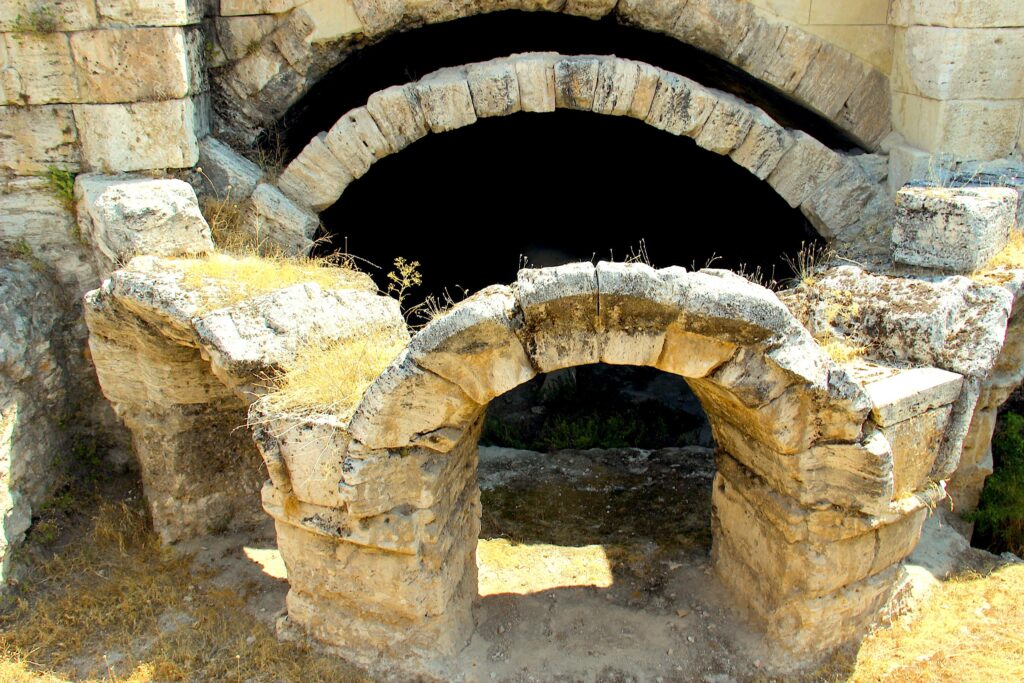
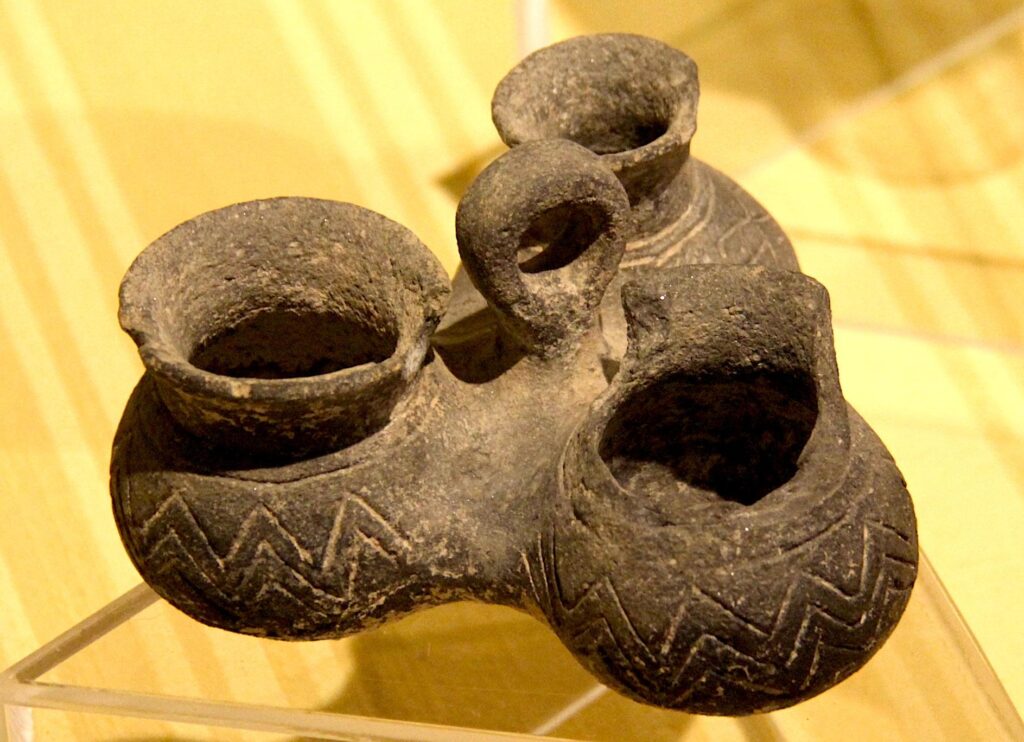

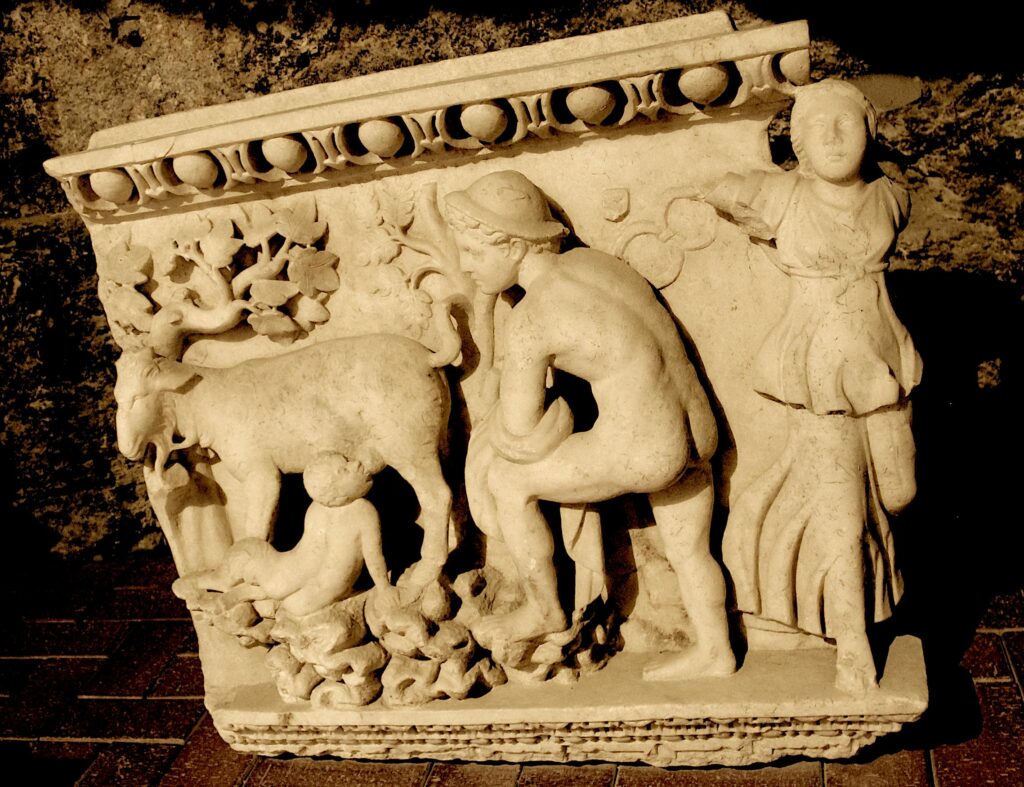

The hall of sarcophagi and statues consists mainly of artefacts from the excavations of Hierapolis and Laodikeia. Among the artefacts are the reliefs of gladiator fights and bullfights unearthed in excavations in Tripolis Street in Hierapolis and the sarcophagi unearthed in the Ancient City of Laodikeia, artistic examples of the Roman Period.
The hall of small works exhibits artefacts chronologically from civilizations since the 4th millennium B.C. Among the works are items from the Beycesultan Höyük (mound) in the Çivril district of Denizli province excavated by the British Archaeological Institute between 1954 and 1959. Along with the terracotta pots, idols, and stone artefacts, there are terracotta oil lamps, glass artefacts, necklaces, and metal jewellery from the Phrygian, Hellenistic, Roman, and Byzantine Periods.

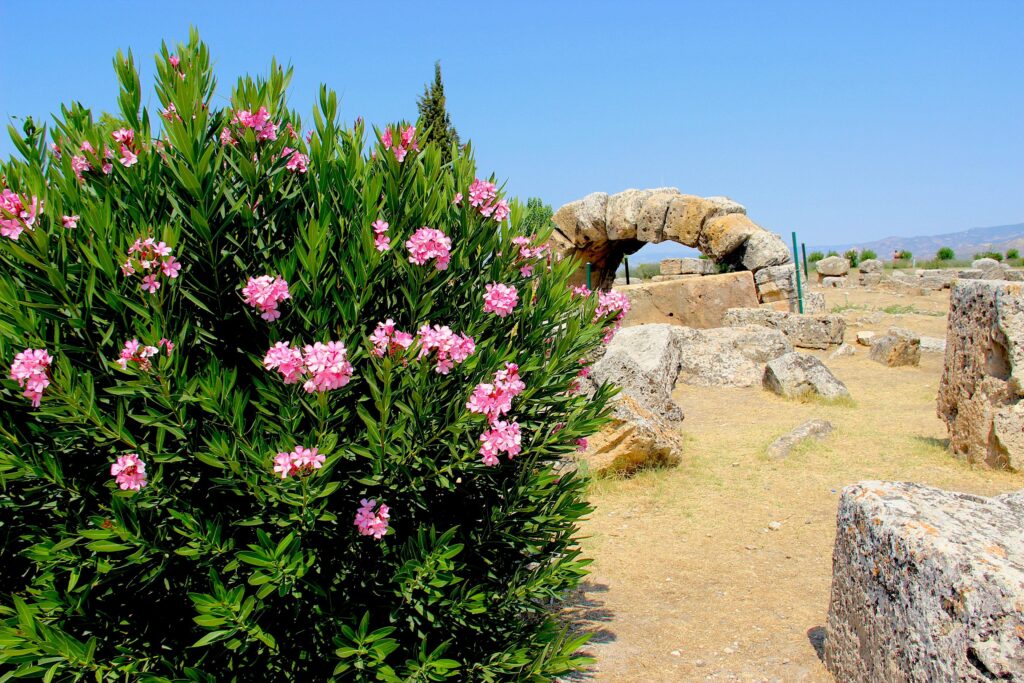
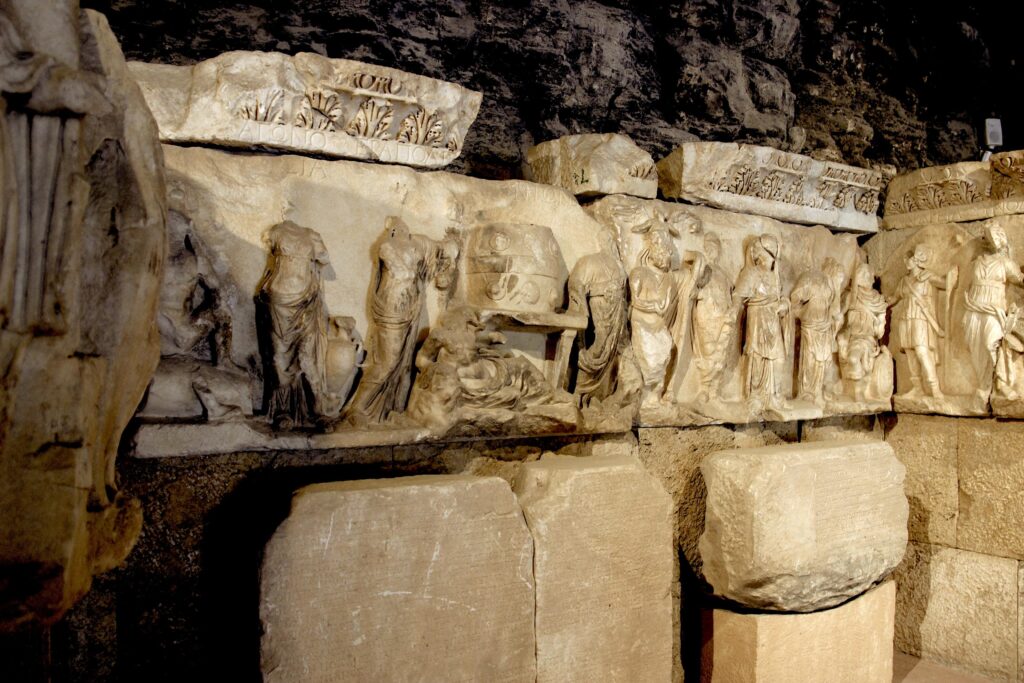
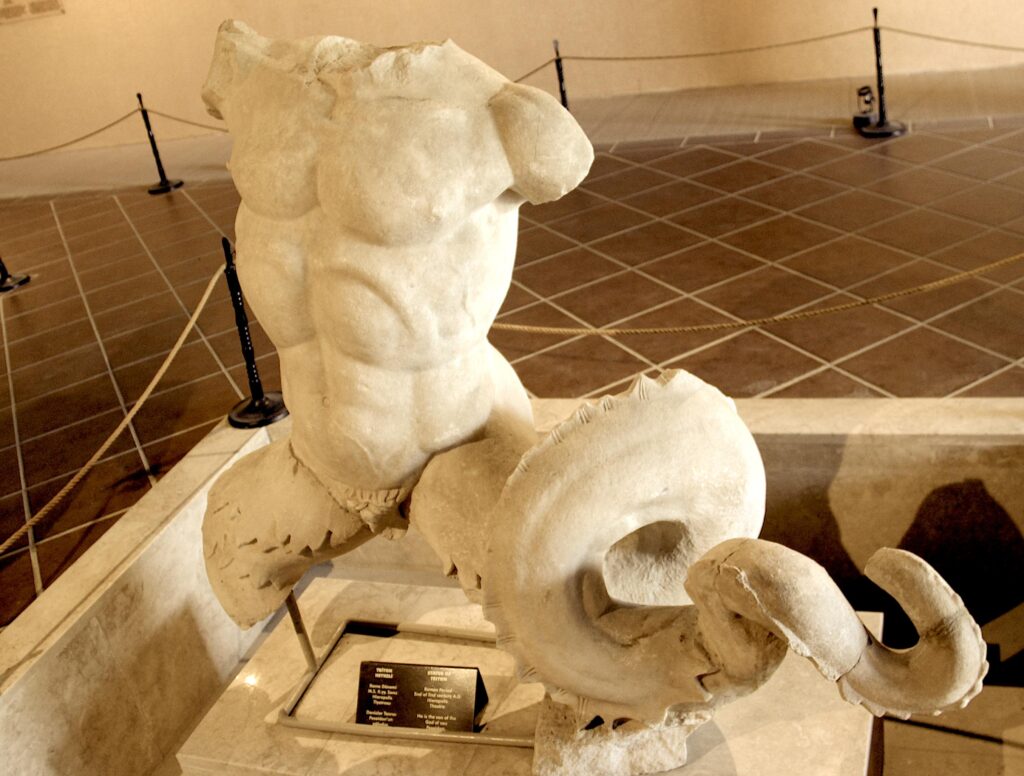
Frontinus Street
The collonaded Frontinus Street is named after Sextus Julius Frontinus (40 – 103 A.D.), the Roman proconsul of the Province of Asia in 86 A.D. and a prominent Roman civil engineer, author, and soldier. This main street of Hierapolis divided the city into two, with smaller streets joined to the main street at a right angle, forming a regular grid. From the edge of the necropolis, the street began with the monumental Gate of Domitian and then ran to the gymnasium on the southern side of Hierapolis. Along the street, originally 14 meters wide, were numerous public buildings and fountains.
At the end of the 4th century A.D., in the early Byzantine period, the southern and northern gates were erected on the street within the newly marked defensive walls of the city. The street was narrowed as new residential properties encroached. Walking down the whole length of the ancient street to the south gate is impossible since not all fragments have survived, and some of the colonnades lay at the bottom of the ancient pool. The best-preserved section is between the Domitian and Northern Byzantine Gate.
Cleopatra’s Pool
Cleopatra’s natural thermal pool is open to public use for an additional admission fee. The temperate range is between 36ºC and 57°C, acidity of 5.8pH, radioactive minerals and very high radon levels. The spa water contains bicarbonate, sulphate, carbon dioxide, and iron and is used for drinking cures.
